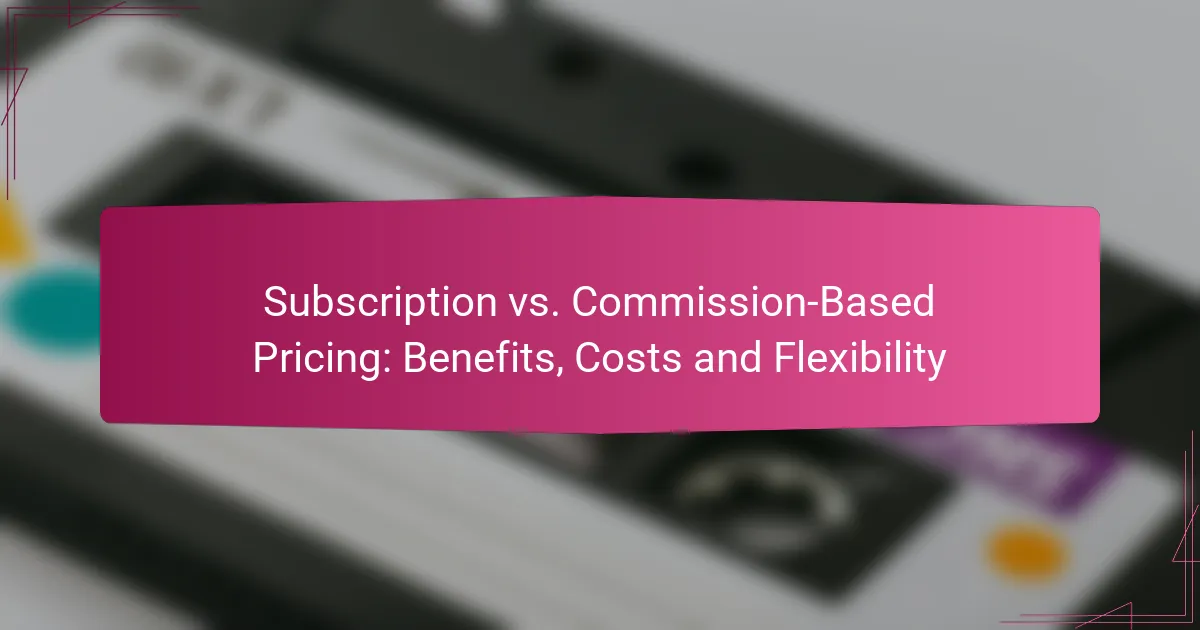When deciding between subscription and commission-based pricing models, businesses must weigh the benefits, costs, and flexibility each approach offers. Subscription pricing provides consistent revenue and fosters long-term customer relationships, while commission-based pricing aligns costs with performance and customer satisfaction. Understanding these differences is crucial for selecting the model that best supports a company’s financial goals and growth strategies.

What are the benefits of subscription pricing for digital products?
Subscription pricing offers several advantages for digital products, including consistent revenue, stronger customer relationships, and lower costs for acquiring new customers. This model allows businesses to predict income and invest in long-term growth while providing ongoing value to users.
Predictable revenue stream
A subscription model creates a predictable revenue stream, allowing businesses to forecast income more accurately. This stability helps in budgeting and planning for future investments, as companies can rely on a steady flow of cash each month or year.
For example, a software company charging $10 per month for its service can expect to earn $120 annually per subscriber. This predictability is crucial for managing operational costs and scaling the business effectively.
Enhanced customer loyalty
Subscription pricing fosters enhanced customer loyalty by encouraging ongoing engagement with the product. Subscribers are more likely to develop a habit around using the service, leading to higher retention rates.
Offering exclusive content, features, or discounts to subscribers can further strengthen this loyalty. For instance, a streaming service might provide early access to new shows for its subscribers, making them feel valued and less likely to cancel.
Lower customer acquisition costs
With a subscription model, businesses often experience lower customer acquisition costs compared to one-time purchase models. This is because satisfied subscribers can become advocates, referring new customers without the need for extensive marketing efforts.
Additionally, the lifetime value of a subscriber can be significantly higher, as they may continue to pay for the service over several months or years, reducing the need for constant new customer outreach.
Access to continuous updates
Subscription pricing allows customers to receive continuous updates and improvements to the product without additional costs. This ongoing enhancement keeps the service relevant and competitive in a rapidly changing market.
For example, a digital design tool that updates its features regularly can keep users engaged and satisfied, as they benefit from the latest tools and functionalities without having to purchase new versions.
Scalability for businesses
The subscription model is inherently scalable, allowing businesses to grow their customer base without a proportional increase in costs. As more subscribers join, companies can spread their fixed costs over a larger revenue base.
This scalability is particularly advantageous for digital products, where the cost of serving additional customers is often minimal. For instance, an online course platform can add thousands of new users without significant additional expenses, maximizing profit margins as it scales.

What are the benefits of commission-based pricing for digital products?
Commission-based pricing offers several advantages for digital products, primarily focusing on performance and customer satisfaction. This model aligns the interests of both the provider and the customer, as costs are directly tied to the value delivered.
Performance-based earnings
Commission-based pricing allows providers to earn based on the performance of their digital products. This means that the more successful the product is in generating sales or leads, the higher the earnings for the provider. This model incentivizes quality and effectiveness, as providers are motivated to enhance their offerings to maximize their income.
For example, a software company might charge a commission on each sale made through its platform, ensuring that its revenue grows as its users succeed. This creates a win-win scenario where both parties benefit from improved performance.
Lower upfront costs for customers
With commission-based pricing, customers often face lower upfront costs compared to subscription models. They typically pay only when they achieve specific results, making it easier for them to invest in digital products without significant financial risk. This can be particularly appealing for startups or small businesses with limited budgets.
For instance, a customer may opt for a commission-based service that charges a percentage of sales rather than a hefty monthly fee, allowing them to allocate funds more flexibly based on their revenue generation.
Flexibility in pricing models
Commission-based pricing provides flexibility in how services and products are priced, allowing for various arrangements tailored to customer needs. Providers can offer tiered commission rates based on performance metrics or sales volumes, accommodating different customer segments and their respective budgets.
This adaptability can lead to innovative pricing strategies, such as offering lower commissions for higher sales volumes, encouraging customers to scale their usage while benefiting from reduced costs.
Alignment with customer success
Commission-based pricing inherently aligns the success of the provider with that of the customer. Since providers earn more when customers succeed, they are likely to invest in support, resources, and improvements that enhance the customer experience. This fosters a collaborative relationship focused on achieving shared goals.
For example, a digital marketing agency may charge a commission based on the revenue generated from campaigns, ensuring that they remain committed to delivering effective strategies that drive customer success. This alignment can lead to long-term partnerships and sustained growth for both parties.

How do subscription and commission-based pricing compare in terms of costs?
Subscription pricing typically offers more predictable costs over time, while commission-based pricing can fluctuate significantly based on sales volume. Understanding these differences can help businesses choose the pricing model that best aligns with their financial strategies.
Subscription pricing often has lower long-term costs
Subscription pricing generally involves a fixed fee paid regularly, which can lead to lower overall costs for businesses. For example, a monthly subscription might cost a few hundred dollars, but over a year, this can be more economical than paying a commission on every sale.
Additionally, subscriptions can foster customer loyalty, reducing churn rates and stabilizing revenue. This predictability can help businesses budget more effectively and allocate resources efficiently.
Commission-based pricing can lead to higher variable costs
Commission-based pricing ties costs directly to sales performance, which can result in higher expenses during peak sales periods. For instance, if a business pays a 10% commission on sales, a surge in sales can significantly increase total costs, making budgeting more challenging.
This model may benefit businesses with fluctuating sales, as they only pay when revenue is generated. However, the unpredictability of costs can complicate financial planning, especially for businesses with tight margins.
Impact on cash flow management
Subscription pricing enhances cash flow management by providing consistent revenue streams, making it easier to forecast income and expenses. This stability allows businesses to plan investments and operational costs more effectively.
In contrast, commission-based pricing can create cash flow challenges, particularly in slow sales months. Businesses may struggle to cover fixed costs when commissions are low, necessitating careful cash flow monitoring and management strategies to avoid shortfalls.

Which pricing model offers more flexibility for digital products?
Subscription pricing typically offers more flexibility for digital products compared to commission-based pricing. With subscription models, businesses can create various tiers to cater to different customer needs, while commission-based models often tie earnings directly to sales performance, limiting adaptability.
Subscription pricing allows for tiered offerings
Subscription pricing enables businesses to design multiple tiers, each with distinct features and pricing. This approach allows customers to choose a plan that best fits their needs and budget, enhancing user satisfaction and retention. For example, a software service might offer basic, standard, and premium plans, each providing different levels of access and support.
Additionally, tiered offerings can encourage upselling, as customers may start with a lower-tier plan and upgrade as their needs grow. This flexibility can lead to increased revenue over time, as businesses can adjust their offerings based on customer feedback and market trends.
Commission-based pricing adapts to market demand
Commission-based pricing can be responsive to market demand, allowing businesses to adjust their rates based on sales performance. This model is particularly beneficial for platforms that facilitate transactions, such as e-commerce sites or marketplaces, where fees can fluctuate based on the volume of sales or seasonal trends.
However, while this model provides adaptability, it may also lead to revenue unpredictability. Businesses should monitor sales closely and be prepared to adjust their commission rates to remain competitive. For instance, during peak shopping seasons, lowering commission rates might attract more sellers, ultimately increasing overall sales volume.

What factors should businesses consider when choosing a pricing model?
Businesses should evaluate their target market, revenue goals, and operational capabilities when selecting a pricing model. Understanding the trade-offs between subscription and commission-based pricing can help in making an informed decision that aligns with business objectives.
Understanding Subscription Pricing
Subscription pricing involves charging customers a recurring fee for access to a product or service. This model can provide predictable revenue and foster customer loyalty, as users are more likely to stay engaged with a service they pay for regularly.
When considering subscription pricing, businesses should assess customer willingness to commit to ongoing payments. For example, software-as-a-service (SaaS) companies often use monthly or annual subscriptions, which can range from a few dollars to several hundred, depending on the service offered.
Understanding Commission-Based Pricing
Commission-based pricing entails charging a fee based on the sales generated through a platform or service. This model aligns the interests of the provider and the customer, as both parties benefit from increased sales.
Businesses should consider the variability of income with commission-based pricing, as revenue fluctuates with sales volume. For instance, e-commerce platforms often charge a percentage of each sale, which can range from 5% to 20%, depending on the industry and service level.
Benefits and Costs of Each Model
Subscription pricing offers stable cash flow and customer retention but may require significant upfront marketing efforts to attract subscribers. Conversely, commission-based pricing can lead to higher earnings during peak sales periods but may result in unpredictable income streams.
Businesses should weigh these benefits against their operational costs. For example, subscription models may incur higher customer support costs, while commission models may require robust sales tracking systems.
Flexibility and Scalability
Subscription pricing can limit flexibility, as customers may be locked into contracts. However, it allows for easier scaling of services as the customer base grows. In contrast, commission-based pricing offers more flexibility in adjusting fees based on market conditions but may not scale as easily if sales volume fluctuates.
To maximize flexibility, businesses should consider hybrid models that combine elements of both pricing strategies. For instance, offering a lower subscription fee with a small commission on sales can attract a broader customer base while maintaining revenue stability.
